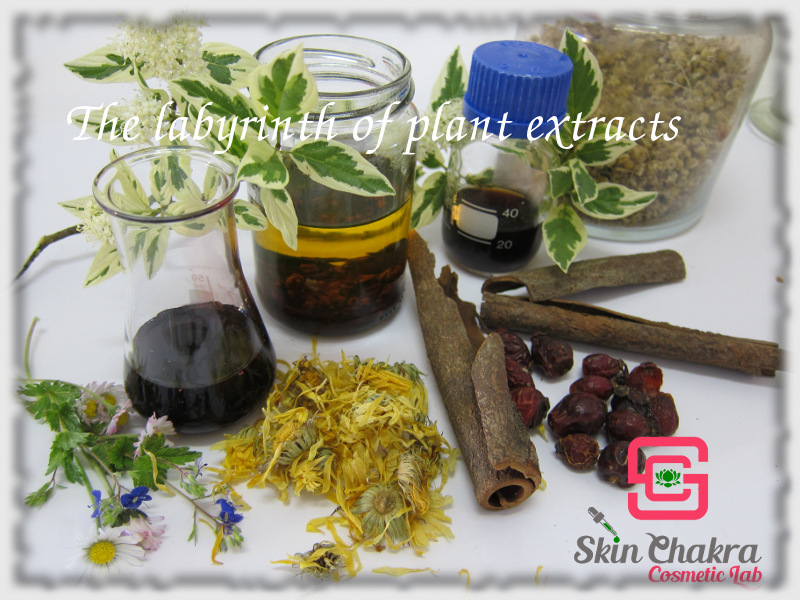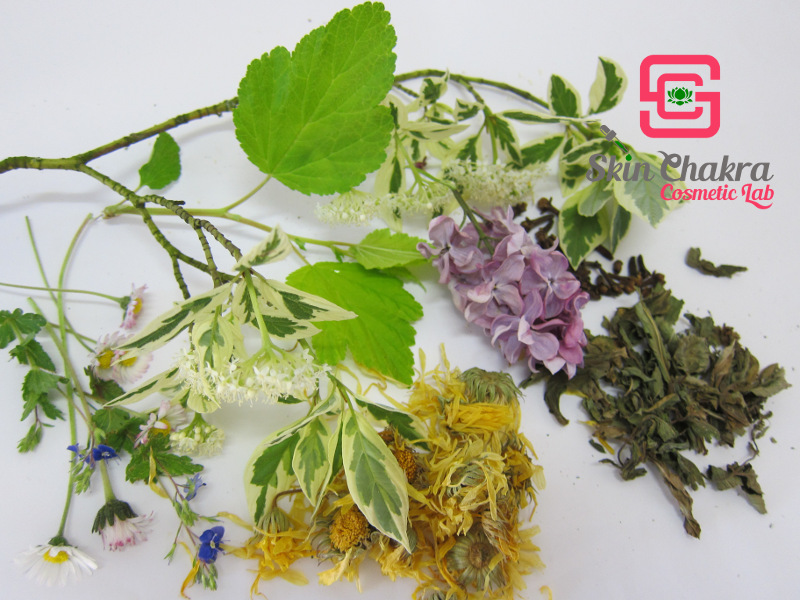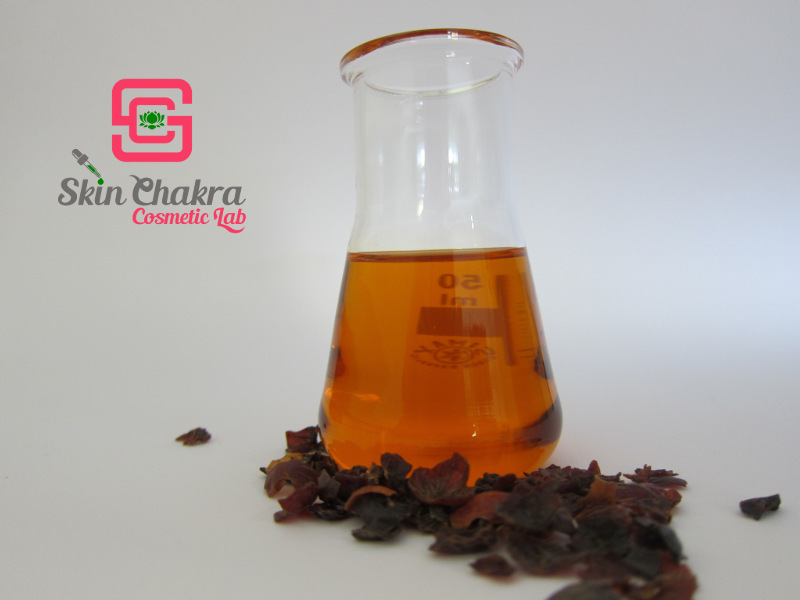
Donnerstag, 10. Mai 2018
Welcome into the labyrinth of plant extracts (part I)
Without any doubt, plant extracts are among the most important and fascinating ingredients in natural cosmetics. Infusions and extracts have been used for thousands of years in herbalism, home remedies and traditional and home made cosmetics and although the methods of extraction or the carriers have slightly changed, the principle is the same.
In this era of global and electronic commerce, we are able to purchase the most exotic plants and herbs or their extracts with one mouse click. This is a privilege unimaginable 20 years ago and just like any other modern age privilege, it has its own limitations and disadvantages.
The world of plant extracts could be quite overwhelming to beginners of cosmetic formulation. The terms are wildly interchanged and exchanged and the information submitted by the retailers (and unfortunately even by manufacturers) are insufficient or even sometimes misleading.
To help new students of cosmetic formulation through this labyrinth of plant extracts and spare them frustrations and waste of their limited budget I’ve listed a few hints and tips that I’ve gathered through years of experience of working with suppliers and students (both ends of the supply chain)
1- Infusion, decoction, maceration, percolation or extraction?
These terms are often exchanged and interchanged and although there is no standard terminology very often:
Infusion and decoction are performed by soaking the plant material (fresh or dried) with hot to boiling water and filtration after a short period of time.
Maceration is usually performed by soaking the plant material (dried) in an oil or a blend of oils.
Read my blog post : 8 best botanical oils for botanical oil infusions here.
Depending on the temperature and mechanical agitation as well as exposure to sunshine, the maceration time varies between a few hours to a few weeks before the plant material is filtered.
By percolation, a solvent (This could be water (very seldom), alcohol or organic solvents such as hexane) is circulated through the plant material for several cycles, extracting components that are soluble in that specific solvent. When using a volatile organic solvent such as hexane, the solvent is usually evaporated and it is the dried (powder) extract which is used. Although this is a very popular extraction method in pharmacy, hydrocarbon (organic) solvents such as hexane are not allowed in natural and organic cosmetics.
Although all of the above methods are used to “extract” certain active ingredients and plant metabolites, it is common to use the term “extraction” when a kind of mechanical/physical force is involved:
1- Mechanical extraction
This is one of the most conventional methods of extraction that works for both lipophilic and hydrophilic extracts. Mechanical force and agitation are used to crush the plant cells (fresh or dried plant). This extraction method is one of the most economical methods. Usually either the system is heated externally to improve the yield or the heat created by the system is used for this purpose. This method has the disadvantage that heat sensitive and volatile components might be damaged.
2- Microwave extraction
Microwave energy is used to assist penetration of the solvent into cell walls. This method is not quite commercially available and is rather used in research. Another drawback is its limitation to polar solvents for extraction. Water is one of the solvents with the highest polarity which is used here. You can not use plant oils (which are rather nonpolar) for this kind of extraction.
3- Ultrasound extraction
This is one of the most innovative extraction methods. Instead of mechanical energy and heat, ultrasound energy under controlled temperature is used to break the cell walls and assist penetration of the carrier into cell membrane. This extraction method is performed near to RT and hence although the yield is higher compared to the mechanical extraction, heat sensitive components remain intact. This method works for both lipophilic and hydrophilic carriers.
4- Supercritical fluid extraction (SFE)
Read my blog post about CO2 extracts here.
This method of extraction is a world of its own and I recommend you to go and read my previous post about CO2 extraction. Usually a carrier (such as CO2 gas) is compressed so that it behaves like a liquid. It passes through plant material and dissolves CO2 soluble components of the plant (lipophilic components and volatile matter). After the extraction is completed, the CO2 is recovered from the extract and used for other cycles of extraction and the product is a pure lipophilic extract without any carrier or solvent. Depending on the process parameters (temperature and pressure) the CO2 extract contains all lipophilic components (total extract) or a selected number of components (select extract). CO2 extracts are much more expensive compared to conventional extracts, the lower dosage and the higher shelf-life is a compensation for the high price.
Where the confusion starts:
Unfortunately, all of the above extracts, decoctions, infusions etc. are considered “extract” when it comes to cosmetic ingredients nomenclature. It means no matter whether the ingredient you are using is an infusion, an ultrasound extract, a CO2 extract or microwave extract, the INCI naming would be exactly the same.
If you try to decipher a product’s label for example, the name “xy extract” would not help you know about the method of extraction, the carrier or even whether it is a lipophilic or hydrophilic extract.
When it comes to purchasing extracts, it can become even more confusing as long as the supplier does not provide you with necessary information.
You certainly don’t want to pay for a lipophilic extract when you need an extract for a toner or micellar water and vice versa, not paying for a water infusion when you need a lipophilic extract for a balm.
So what?
What you need to know when you order/ purchase an extract
1- The INCI name of the extract
this must include:
1- the linnean name of the plant and the parts used for extraction, for example: curcuma longa root extract
Keep in mind that the INCI naming would not disclose the method of extraction to you. This information should be provided by the supplier as additional information in a product brochure or technical data sheet
2- The carriers
If the extract contains a carrier, the carrier name should be mentioned in the INCI name of the product (on technical data sheet, certificate of analysis and on safety data sheet)
If there is no carrier, the product brochure or technical data sheet (as well as online product information) shall provide you with a clear explanation of the extraction method and how the carrier was removed. For instance:
CO2 extract, aqueous extract and the water was removed via freeze drying, alcoholic extract and the alcohol was removed by vacuum evaporation etc.
EXTRACTION needs a carrier/solvent. The solvent may remain in the finished product that you are purchasing or may be removed afterwards. If the carrier is removed, it wouldn’t be mentioned anymore in the INCI name of the product, on certificate of analysis or on the safety data sheet (because it is not in the ingredient you are purchasing). However, even though it is not present in the final ingredient, its nature is extremely important because :
a- it defines whether the final extract is hyrophilic or lipophilic, how you can dissolve the extract and use it in a formulation and an approximate idea of which active components might be in the extract
b- it defines whether you can use the extract in organic and natural formulations or not
The information about the solvents and the method of their removal should be provided by the supplier. If the supplier does not provide you with this information and tries to use fanciful terms and explanations instead (such as : this is a new patented procedure and we can not disclose the details) keep your hands from that extract.
To rescue modern readers (cellphone generation) from getting bored, we'll continue this topic in a subsequent post. Meanwhile you can go back and read my previous posts about herbal extracts:
Here you can proceed to part II of this blog post.
From petals to extract: How to make Calendula extract (lipophilic)
From Sprout to Extract: why extracting sprouts (part I)
From Sprout to Extract: (part II)
How to filter your herbal extracts and infusions (part I)
How to make herbal extracts with your "Blendia"
Plant extracts 101: Part I
Plant Extracts 101 (Part II): What you need to know before purchasing your plant extracts
Plant Extracts 101(Part III): Phytochemicals in cosmetics
Plant Extracts 101(Part IV): Phytochemicals in cosmetics: Terpenoids
Plant Extracts 101(Part V): Phytochemicals in cosmetics: Polyphenols
BeHappy and have fun



